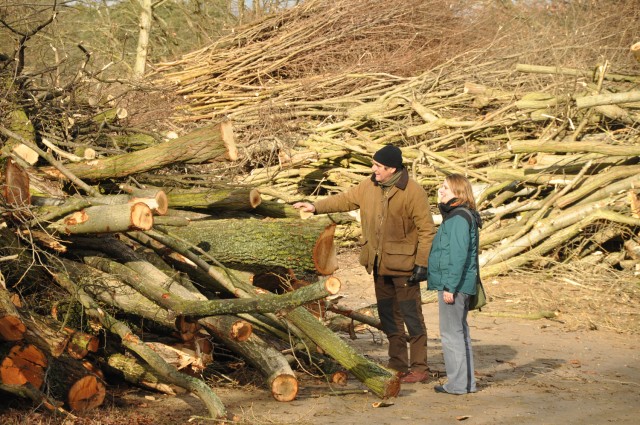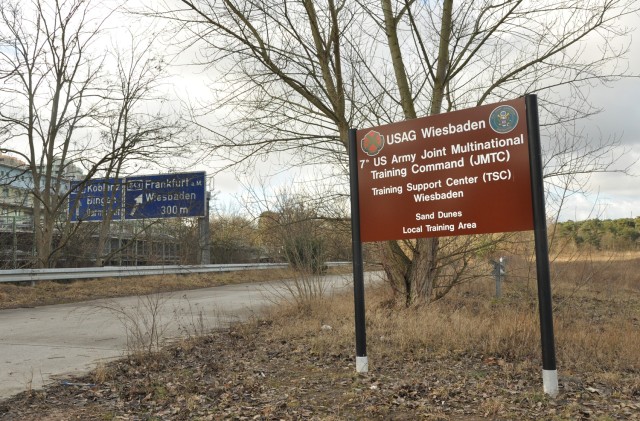WIESBADEN, Germany Aca,!" Sometimes too much of anything is definitely not a good thing.
ThatAca,!a,,cs indeed the case at the Mainz Sand Dunes Local Training Area where an invasive tree species and other plant invaders have run rampant threatening rare plants and animals, and impacting training operations.
As part of a unique Flora, Fauna Habitat as identified in a European directive known as Natura 2000, the training area is home to several rare kinds of plants and animals thanks to its unusually nutrient-poor soil, according to Gordon Adam, an environmental technician with the U.S. Army Garrison WiesbadenAca,!a,,cs Directorate of Public Works. Aca,!A"The area contains wind-blown sands from the last Ice Age. Because of its very low nutrient soil it promotes the growth of a certain kind of flora including several rare species. Aca,!A| WeAca,!a,,cve got some very rare birds there as well.Aca,!A?
Other rare species include butterflies, beetles, bats, bees, spiders, grasshoppers and grass species such as Quackgrass.
Adam added that many of the U.S. ArmyAca,!a,,cs training areas in Germany are unique natural habitats for any number of different plant and wildlife species.
Aca,!A"Army Regulation 200-1 requires us to maintain the lands for which we are responsible,Aca,!A? he said, explaining that close cooperation with German authorities led to a Threatened and Endangered Species survey in 2007.
Working closely with the German Forestry Service, the Training Support Center Wiesbaden from the Training Support Activity-Europe and the 7th U.S. Army Joint Multinational Training Command, and the German environmental authorities, members of the DPWAca,!a,,cs Environmental Office arranged for the survey to be conducted by a contracted firm, WBI-GIBS. Aca,!A"Our company, which has a lot of experience in the natural resources field, conducted the survey in July 2007 and developed a management plan in response to the survey in December 2008,Aca,!A? said Anja Lundquist, a core conservation manager with WBI-GIBS.
Survey results found that encroaching urban development, resulting pollution and the abundance of Black Locust Trees planted in the eastern part of the installation were all leading to a dramatic shift in the soil makeup and ecological diversity.
As a nearby area offering around-the-clock training opportunities for all of the U.S. Army units in Wiesbaden and other garrisons, the Sand Dunes LTA is a vital asset, said Ron Clendenen, WiesbadenAca,!a,,cs Training Support Center supervisor. Units including elements of the 66th Military Intelligence Brigade, 421st Multifunctional Medical Battalion, 212th and 501st Military Police Companies, 1st Armored Division Special Troops Battalion, 102nd Signal Battalion and 557th Medical Company are among the local units which have relied on the area to hone their war-fighting skills. Aca,!A"In the 86 training days alone it was available so far this fiscal year, in the first quarter we saw an over 50 percent use by units.Aca,!A?
Not only did the abundance of the invasive trees threaten the local eco-system, but the trees and brambles also posed a threat to Soldiers conducting training in the training area, Clendenen said.
Thanks to an $80,000 project, trees, plants and other shrubbery have been thinned out.
Aca,!A"WeAca,!a,,cre getting more open area back,Aca,!A? he said, Aca,!A"and wonAca,!a,,ct have the threat of injury with the thorns from the Black Locust trees.Aca,!A?
An additional $75,000 future project will help maintain the training area, said Adam, explaining that contractors will return to the area over the next several years to remove new growth and remove root stock so that it wonAca,!a,,ct come back again. Aca,!A| WeAca,!a,,cre working closely with the German authorities Aca,!A| monitoring the project from the U.S. side.Aca,!A?
While local German citizens are welcome to use the area for recreation such as walking and running, signs warn that entrance is to be avoided when military training is in progress for safetyAca,!a,,cs sake. Clendenen added that dumping waste in the area is strictly forbidden and that Training Support Center staff ensure that units leave the area in as pristine shape as when they starting using the facility.
The survey also found that animal feces left by dog walkers in the training area had a negative effect on the biological diversity Aca,!" leading to an environmental plea that dog walkers pick up after their animals.
Working closely with their German counterparts, U.S. Army environmentalists and training support providers are living up to the Defense DepartmentAca,!a,,cs motto of being good stewards of the earth wherever Soldiers are called upon to serve.






Social Sharing